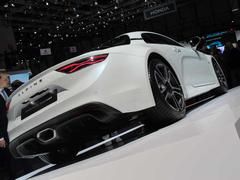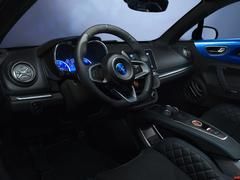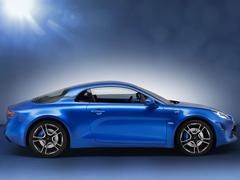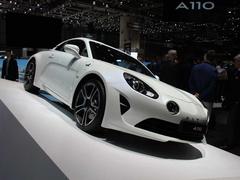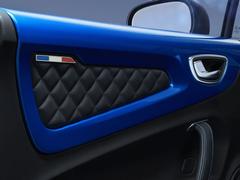Alpine A110 - Geneva 2017
Alpine A110 goes full frontal, baring a 1,103kg kerbweight, 252hp engine and seven-speed DCT
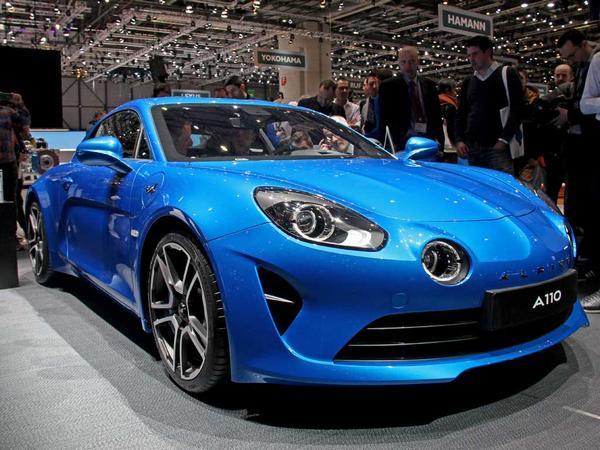
It does 155mph, hitting 62mph in 4.5 seconds on the way, but the stat Alpine is most proud of is the one that it's been holding back - the weight. The 'unladen' figure of 1,103kg before options is more than an Alfa Romeo 4C's dry weight of 895kg (though that apparently depends on whose scales you're using) and the Lotus Elise Sport 220's 914kg. It's still an impressive measure though, especially compared with the car it's really aimed at - the Porsche Cayman.
That equates to a power-to-weight ratio of 228hp per tonne, against 219hp per tonne for an equivalent £41,800 PDK-equipped 718 Cayman from its 300hp and 1,365kg DIN kerbweight. Unlike the Alpine the Cayman is, of course, available as a manual and this weighs 30kg less for 224hp per tonne. Meanwhile the 350hp 718 Cayman S boasts 258hp per tonne as a manual and 253hp per tonne with PDK, the latter a £50,756 car.
So it appears the big brains at Alpine have done their sums, slotting the A110 between the 718 Cayman and 718 Cayman S. UK pricing is TBC but Alpine has confirmed 58,500 euros including taxes for the fully loaded Premiere Edition in the French market - in France a 718 Cayman PDK by the same measure is 56,810 euros before any other options. So it's on the money.
But how did Alpine hit that weight? The aluminium chassis is one significant step, favoured according to engineering head David Twohig because of its lower cost and better finish than carbon fibre, and inherent benefits over steel. Then there's a host of other clever tricks, from the fixed-back seats that weigh 13.1kg each - around half that of the seat in a Megane RS - to a windscreen washer system that is so efficient it justifies a washer bottle 2.5 litres smaller than standard, for instance.
Now, back to the engine. Howls of disapproval are already being heard, because there's no getting away from the fact that the engine displacement and outputs look as dinky as the car itself. No matter, says David Twohig, because the brief was to build a car that would compete on agility, not grunt.
"Alpine's history is in cars that pivot around the wheel, that thrill without being overwhelming and that make the driver feel at centre of everything - and that is what we've set out to achieve," says Twohig. Proof will be in the driving; for now we have that 4C-equalling 0-62mph figure of 4.5 seconds against best-case 4.7 seconds for a Sport Chrono equipped 718 Cayman PDK or 4.2 seconds for the equivalent S. While we're playing Top Trumps both Porsches are significantly faster on top speed too - 170mph for the 718 and 177mph for the S.
Weight distribution is 46:54 front to back - aided by the fuel tank sitting in the front. There's also double wishbone suspension at the front and back of the car, new gear ratios for the Getrag-supplied gearbox, deliberately small tyres, an e-diff (configurable through the different driving modes) and an aerodynamic diffuser to create downforce without compromising the rear-end styling. The steering is power-assisted, too - not ideal on paper, but all the better for controlling mass, says Twohig. The comparably light Elise and 4C both, of course, have non-assisted steering, the Elise demonstrating how it should be done with the Alfa Romeo proving otherwise...
"Throughout this project we concentrated on doing it right, so that meant custom pinion sets, a wet clutch, a latest seven-speed gearbox, launch control and three proper driving modes - Normal, Sport and Track - that have a distinct character across the engine and pedal maps and the active exhaust, and the option to go beyond Track and switch ESC completely off," says Twohig.
"The electronic solutions meant we didn't need a limited-slip diff. It would have added weight and complexity, where the reality is that an e-diff set-up can handle these power levels perfectly well. I've tested it and I can promise you that you can get some pretty big angles in Track mode without it feeling like it is about to bite you."
The Michelin Pilot Sports run on 18-inch wheels for the launch car with 205 section up front and 235 at the rear. 17s with 195 front and 225 rear will be standard on future entry-level models. "The tyres look just fine and their performance matches the weight, power and torque we have," says Twohig. "We didn't want loads of mechanical grip, we wanted a car that is mobile and which slides relatively easily under the right circumstances."
That UK price is coming later this year, with right-hand drive production beginning in early 2018. Dare we get excited?
[Jim Holder]
Gassing Station | General Gassing | Top of Page | What's New | My Stuff

